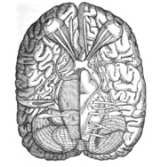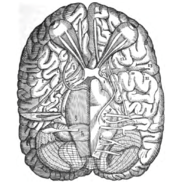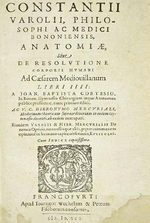
Costanzo Varolio
Encyclopedia

Bologna
Bologna is the capital city of Emilia-Romagna, in the Po Valley of Northern Italy. The city lies between the Po River and the Apennine Mountains, more specifically, between the Reno River and the Savena River. Bologna is a lively and cosmopolitan Italian college city, with spectacular history,...
, 1543 - died Rome
Rome
Rome is the capital of Italy and the country's largest and most populated city and comune, with over 2.7 million residents in . The city is located in the central-western portion of the Italian Peninsula, on the Tiber River within the Lazio region of Italy.Rome's history spans two and a half...
, 1575) was an Italian anatomist and a papal physician to Gregory XIII. He was a pupil to the anatomist Giulio Cesare Aranzio, himself a pupil of Vesalius
Vesalius
Andreas Vesalius was a Flemish anatomist, physician, and author of one of the most influential books on human anatomy, De humani corporis fabrica . Vesalius is often referred to as the founder of modern human anatomy. Vesalius is the Latinized form of Andries van Wesel...
. He received his doctorate in medicine in 1567. In 1569 the Senate of the University of Bologna
University of Bologna
The Alma Mater Studiorum - University of Bologna is the oldest continually operating university in the world, the word 'universitas' being first used by this institution at its foundation. The true date of its founding is uncertain, but believed by most accounts to have been 1088...
created an extraordinary chair in surgery for him with responsibility to teach anatomy as well and where a statue of him is housed at the Anatomical Theatre of the Archiginnasio
Anatomical theatre of the Archiginnasio
One of the main historical rooms in the medical school in Bologna is the Anatomical theatre, in the magnificent Archiginnasio of Bologna, the first unified seat of the University of Bologna...
. Later he is believed to have taught at the Sapienza University of Rome although he is not listed on the role there. Nevertheless, he is known to have had considerable success in Rome both as a physician and as a surgeon and his memorial plaque in that city refers to his great skill in removing stones.
He is best remembered for his work on the cranial nerves
Cranial nerves
Cranial nerves are nerves that emerge directly from the brain, in contrast to spinal nerves, which emerge from segments of the spinal cord. In humans, there are traditionally twelve pairs of cranial nerves...
. He was the first to examine the brain from its base upwards, in contrast with previous dissections which had been performed from the top downwards. In 1573 he published this new method of dissecting the brain whereby he separated the brain from the skull and began the dissection from the base. Varolio described many of the brain's structures for the first time including the pons
Pons
The pons is a structure located on the brain stem, named after the Latin word for "bridge" or the 16th-century Italian anatomist and surgeon Costanzo Varolio . It is superior to the medulla oblongata, inferior to the midbrain, and ventral to the cerebellum. In humans and other bipeds this means it...
or pons Varolii which is a reflex center of respiration and a communication bridge between spinal cord and brain, the crura cerebri
Cerebral crus
The cerebral crus is the anterior portion of the cerebral peduncle which contains the motor tracts, the plural of which is cerebral crura.In some older texts, it is used as a synonym for the entire cerebral peduncle, not just the anterior portion of it....
and the ileocecal valve
Ileocecal valve
The ileocecal valve, or ileocaecal valve, is of a bilabial papilla structure with physiological sphincter muscle situated at the junction of the small intestine and the large intestine, with recent evidence indicating an anatomical sphincter may also be present in humans) Its critical function is...
.

Erection
Penile erection is a physiological phenomenon where the penis becomes enlarged and firm. Penile erection is the result of a complex interaction of psychological, neural, vascular and endocrine factors, and is usually, though not exclusively, associated with sexual arousal...
. Although the “Musculi erectores penis” (i.e. Mm. bulbospongiosi and ischicavernosi) had already been described by Galen in the 2nd century A.D., this knowledge was lost by the time of Varolio, who re-discovered them and gave a surprisingly accurate description of the mechanism of erection although his inaccurate attribution of erection to "erector muscles" continued to be believed by most anatomists for three centuries.
Varolius' work is the following:
De Nervis Opticis nonnullisque aliis praeter communem opinionem in Humano capite observatis. Ad Hieronymum Mercurialem, Patavii apud Paul et Anton. Meiettos fratres, 1573, 8º, 8 and 32 leaves. It consists of a letter to Merculiaris, dated April 1, 1572, his answer, and Varolius' reply to the latter. Appended are three woodcuts pertaining to the brain and drawn by Varolius himself. The engraving is somewhat crude, yet distinct and instructive.
A second work by Varolius, a teleologic physiology of man, was published for the first time after his death:
Anatomiae sive de resolutione corporis humani ad Caesarem Mediovillanum libri iv, Eiusdem Varolii et Hieron. Mercrialis De nervis Opticis, etc. epistolae, Francofurti, apud Joh. Wechelum et Petr. Fischerum consortes, 1591, 8º, 8 and 184 pp. This contains no illustrations. But the former book is republished as a part of this work with unchanged text and the woodcuts recarved in a somewhat different manner.

